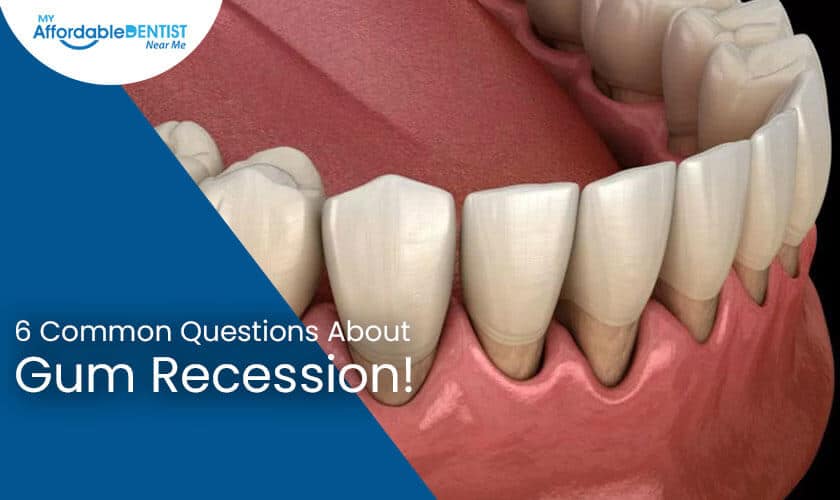6 Common Questions About Gum Recession!
By :
Affordable Dentist | September 30, 2022
Gum recession occurs when the gum line recedes from the teeth, exposing the underlying roots. Numerous factors, such as aggressive brushing, smoking, and even genetics, can be the reason for gum recession. The treatments include antibiotics, mouthwashes, and surgery. You need to know that gum recession cannot be reversed, but proper treatment can help prevent the situation from getting worse. We will discuss important details related to the gum recession in this blog.
What Is Gum Recession?
Gum recession can be defined as a form of gum disease. It occurs when the gum tissue pulls away from your teeth, ultimately exposing the roots underneath. This can make your teeth more susceptible to cavities and sensitive while brushing and eating. Gum recession can be mild, moderate, or severe. It can also affect one or multiple teeth.
Who Are Affected By Gum Recession?
Gum recession can affect individuals belonging to various age groups. It is most common in people above sixty-five years of age. You are more likely to suffer from gum recession if you:
- Suffer from periodontal problems
- Wear braces or other orthodontic treatment
- Use chewing tobacco products
- Have a tongue or lip piercing
- Brush your teeth in an aggressive manner
What Are The Common Symptoms Of Gum Recession?
Tooth root exposure is the most noticeable indicator of gum recession. Some of the other signs of gum recession are
- Discomfort or pain near your gum line
- Sensitivity to cold, heat, or sweets
- Facing the problem of sensitivity while flossing and brushing your teeth
- Sensitivity during dental cleaning sessions
Ignoring the gum recession problem for a long time can be the reason for other complicated problems in the days to come.
What Are The Common Causes Of The Gum Recession?
Your gums can recede due to numerous factors. Some of the major causes include:
- Brushing your teeth in an aggressive manner
- The buildup of dental plaque, which can ultimately form tartar
- Suffering from problems related to periodontal disease
- Severe injury to trauma to the gum disease
- Improper tooth alignment
- Usage of chewing tobacco and smoking
- Piercing in the tongue and lip
Not maintaining a proper dental hygiene routine on a daily basis can contribute to the chances of suffering from gum recession.
How To Fix Receding Gums?
Treatment for gum recession is primarily dependent on the underlying cause. Nonsurgical remedies, such as topical antibiotics, dental bonding, or orthodontics, may help with mild cases of gum recession. However, in most cases, gum recession surgery is required to resolve the issue entirely.
Nonsurgical Treatments
Some of the nonsurgical treatments for gum recession are:
- Topical antibiotics - Your dentist or dental hygienist will work with you on how to brush your teeth more thoroughly if gum recession is the result of periodontal disease. An antibiotic may occasionally be inserted directly under your gums by your periodontist (an expert in gum disease) to help treat gum disease. Scaling and root planing (deep dental cleaning) can be performed under local anesthetic to remove harmful bacteria that cause gum disease.
- Orthodontics - Gum recession may result from crooked, tipped, or rotated teeth. Braces might be an effective treatment option in such cases. Once the tooth moves to the desired alignment, the gum margin may ultimately correct itself with time.
- Dental bonding - Your dentist can also use tooth-colored composite resin to conceal the gum recession. This covers your exposed tooth root, making it less noticeable and much more comfortable.
Gum Recession Surgery
The most reliable and durable form of treatment for gum recession is gum graft surgery. A periodontist usually carries out this procedure.
A gum graft is used to replace your missing gum tissue during this procedure. The graft is typically taken from the roof of your mouth, while it can also come from sterilized human donor tissue.
Your dental surgeon stitches the gum graft into place once it is in the ideal position. Gum grafting procedures are of different types. Your dental professional can help determine which option is perfect for your case. The gum grafting procedures nowadays are minimally invasive.
How To Prevent Gum Recession?
It is not always possible to prevent gum recession, particularly if you are genetically predisposed to having thin gum tissue. Taking good care of your teeth and gums can greatly lower your risk of infection-related gum recession. For instance
- Brush your teeth at least twice a day
- Floss your teeth once a day
- Rinsing your mouth with an antibacterial mouthwash
- Follow the recommendations of your dentist for teeth cleaning
- Use a toothbrush with soft bristles
- Do not smoke or use chewing tobacco
We hope you now know what gum recession is and how it can be prevented with proper instruction. Get in touch with us if you have any further questions related to this topic.


